Key takeaways
- French photography blends art and storytelling, focusing on realism and romanticism, exemplified by Henri Cartier-Bresson’s ability to capture fleeting moments.
- Martine Franck’s techniques emphasize a humanistic approach, the effective use of natural light, and documentary styles that highlight social issues and narratives.
- Her notable works, such as those capturing the elderly and documenting women’s experiences, elevate marginalized voices and spark important conversations.
- Lessons from Franck’s work stress the significance of context in storytelling and the role of photography as a catalyst for social change and empathy.
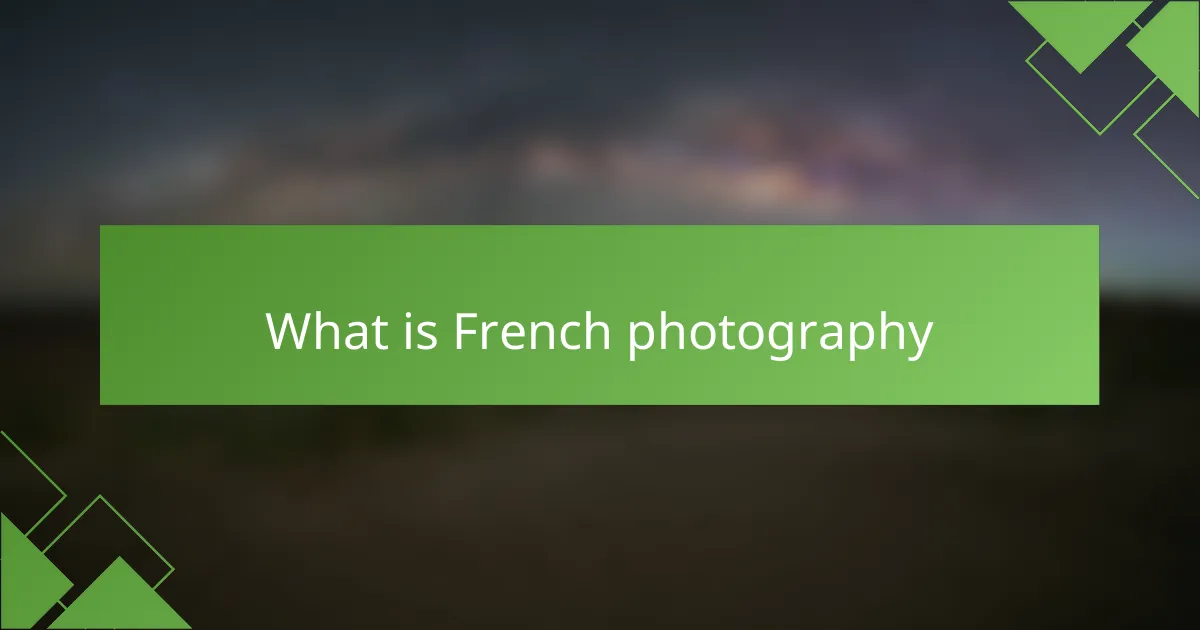
What is French photography
French photography is a captivating blend of art and storytelling, deeply rooted in the culture and history of France. I’ve often found myself mesmerized by how French photographers capture the essence of everyday life, transforming ordinary scenes into extraordinary narratives. Have you ever considered how a single image can evoke such a range of emotions?
The aesthetic in French photography often embraces realism, combined with a certain romanticism that I believe is uniquely French. For example, take a look at the works of photographers like Henri Cartier-Bresson, whose ability to capture fleeting moments always leaves me in awe. It’s as if he had an innate understanding of time and emotion, don’t you think?
Moreover, I appreciate how contemporary French photographers continue to innovate while still honoring traditional techniques. This dynamic evolution makes French photography not just a visual medium but a conversation between past and present. Isn’t it fascinating how each photograph can tell a different story while reflecting the same cultural heritage?
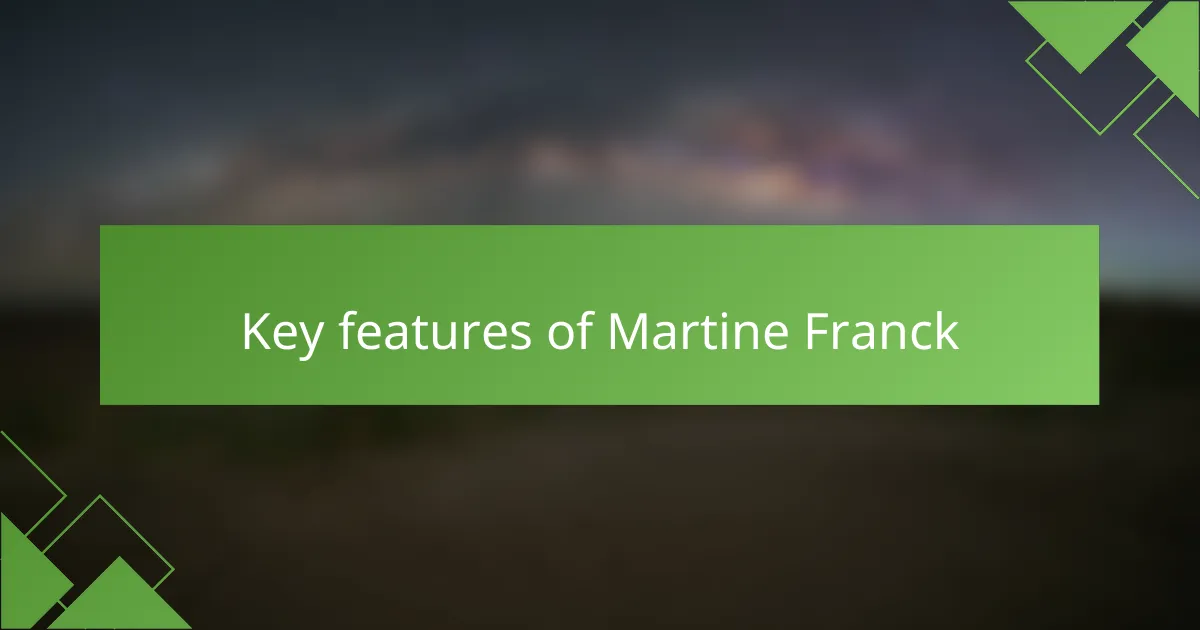
Key features of Martine Franck
Martine Franck’s work is deeply characterized by her humanistic approach and her ability to capture stories through her lens. I was particularly drawn to her commitment to portraying her subjects with dignity and respect. Each photograph feels like a genuine dialogue between the viewer and the subject, which evokes emotion and connection.
One of the striking features of her photography is her use of light. I often found myself enthralled by the way she plays with natural light, creating a warm ambiance that draws you in. The intimacy in her portraits makes you feel as if you are part of the moment, a concept I strive to emulate in my own work.
Her dedication to social issues shines through her documentary style. For instance, I recall seeing her series on the elderly; it was a poignant reminder of the importance of visibility and understanding in our society. Franck’s ability to weave narrative with artistry is something that I believe makes her a unique figure in the world of photography.
| Feature | Description |
|---|---|
| Humanistic Approach | Focus on the dignity and respect of subjects |
| Light Utilization | Mastery of natural light to create intimacy |
| Social Commentary | Documentary style highlighting social issues |
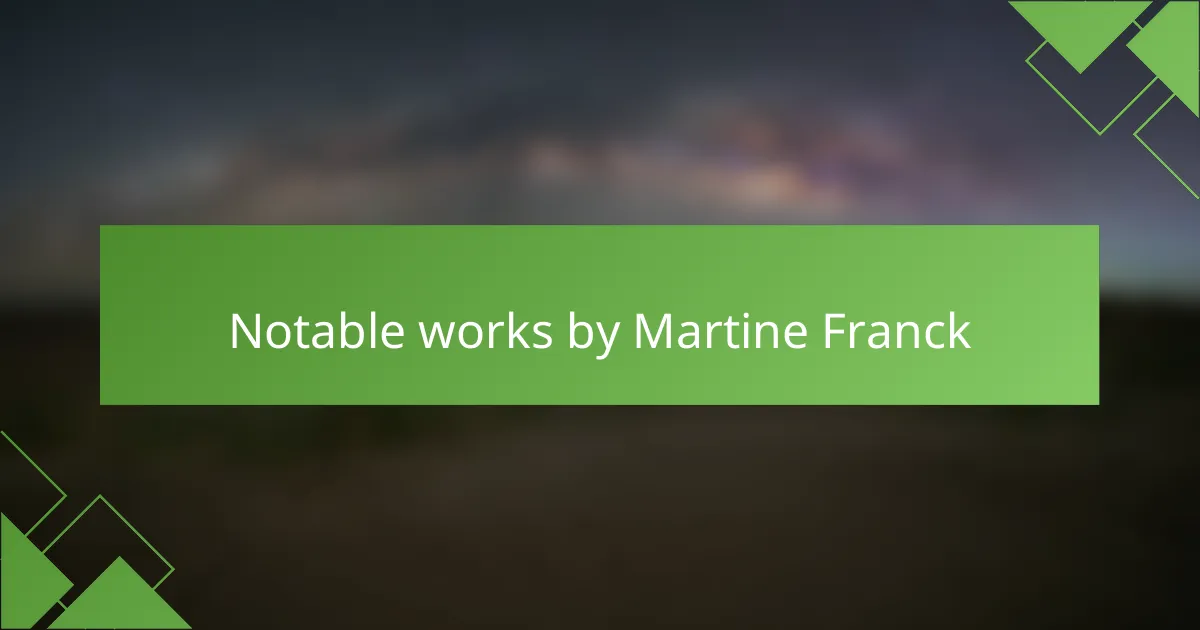
Notable works by Martine Franck
One of Martine Franck’s most notable works is her series capturing the elderly, which profoundly resonates with me. I remember the first time I came across her photographs; each image encapsulated stories of life, wisdom, and resilience. It made me reflect on how often we overlook the rich narratives of older generations. Her approach not only honored her subjects but also sparked conversations around aging and dignity.
Another striking body of work is her documentation of women around the world. Franck has an exceptional skill in portraying the strength and complexity of women, often in their everyday environments. I can’t help but admire how her images serve to elevate women’s voices, showcasing their narratives with depth and empathy. It resonates deeply with my belief in the importance of representation.
Lastly, her photographs of humanitarian efforts and social causes stand out as powerful visual statements. I recall a particular series about refugee experiences that left an indelible mark on my perspective. The raw emotion captured in those moments urges us to acknowledge the struggles of others. Each click of her camera felt like a call to action, reminding me of our shared humanity in an increasingly disconnected world.
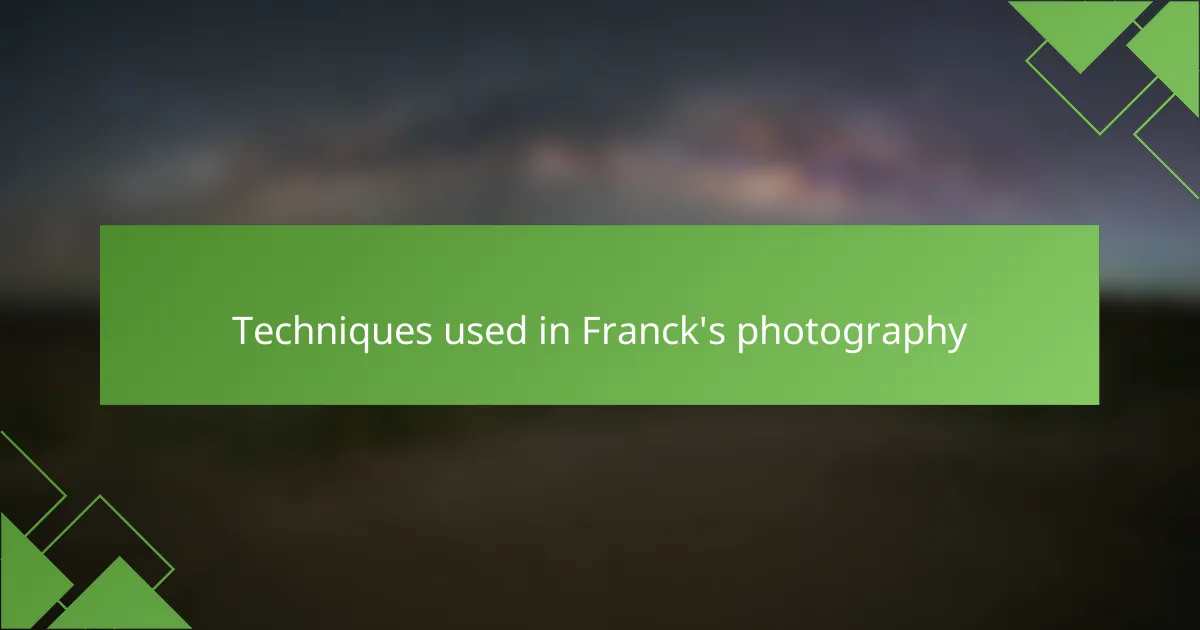
Techniques used in Franck’s photography
Martine Franck’s techniques are nothing short of captivating. One thing that consistently strikes me is her use of framing and composition. She often employs a documentary style, placing her subjects in their environments to create profound narratives. This approach makes me question how much our surroundings define who we are—something that surely resonates with anyone who values context in storytelling.
Her attention to detail is another thing I admire. Take, for instance, her portraits; Franck’s ability to capture the subtle expressions and emotions of her subjects creates an intimate connection with the viewer. I recall being particularly moved by a photograph of an elderly woman gazing out a window, as if lost in thought. It made me wonder about the stories hidden behind those eyes, reinforcing the idea that every photograph is a gateway into someone’s world.
Moreover, Franck’s engagement with social issues through her work feels essential in today’s visual landscape. I remember feeling a powerful wave of empathy while viewing her images that illustrated the plight of refugees. They were not just photos; they were a call to action, reminding us of the importance of human connection and understanding. Isn’t it fascinating how a single photograph can challenge our perspectives and invite us to reflect on our responsibilities as part of a global community?
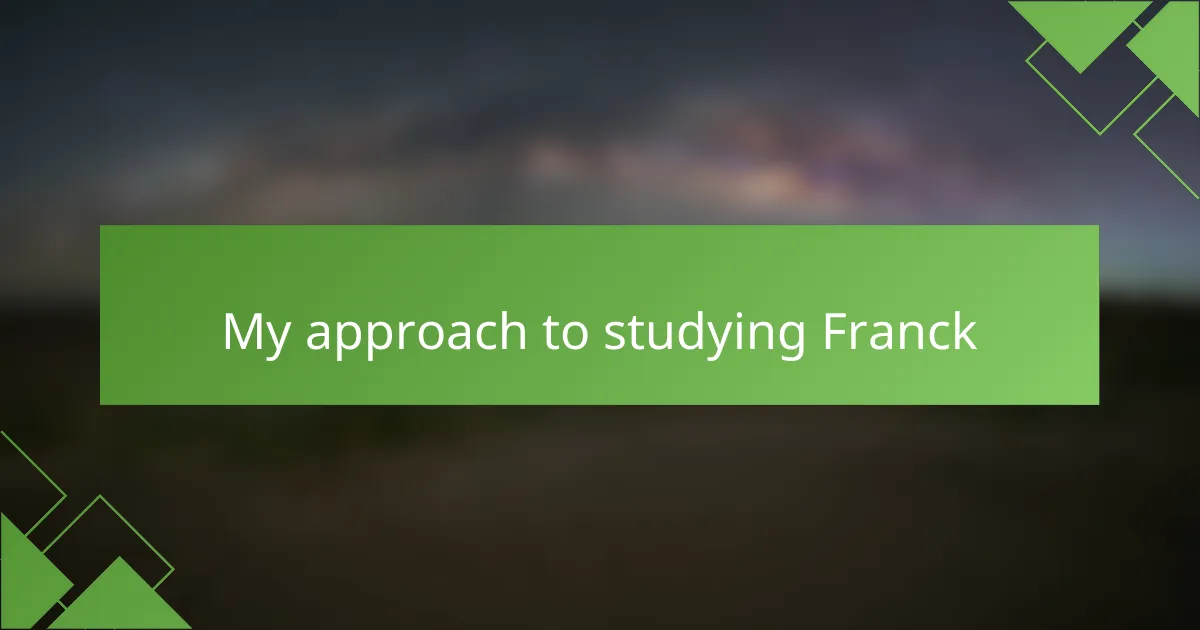
My approach to studying Franck
My approach to studying Martine Franck was both structured and intuitive. I started by delving into her most iconic works, allowing myself to absorb her unique perspective on human connections and social issues. One experience that stuck with me was watching a documentary about her life; it added a personal layer to her images and deepened my appreciation for her artistry.
As I explored her portfolios, I took notes not just on technical aspects but on the emotions each photograph evoked. This process transformed my understanding of photography from simply capturing moments to telling compelling stories. There’s a depth in Franck’s work that resonates with my own beliefs about the power of visual narratives, making every viewing an enlightening experience.
| Key Aspects of Martine Franck’s Work | My Reflections |
|---|---|
| Human Connection | Her ability to capture candid emotions reminds me of my own family gatherings. |
| Social Issues | Her focus on marginalized communities inspires me to be more aware of social justice. |
| Documentary-Style Photography | This approach encourages me to see the world through a storytelling lens. |
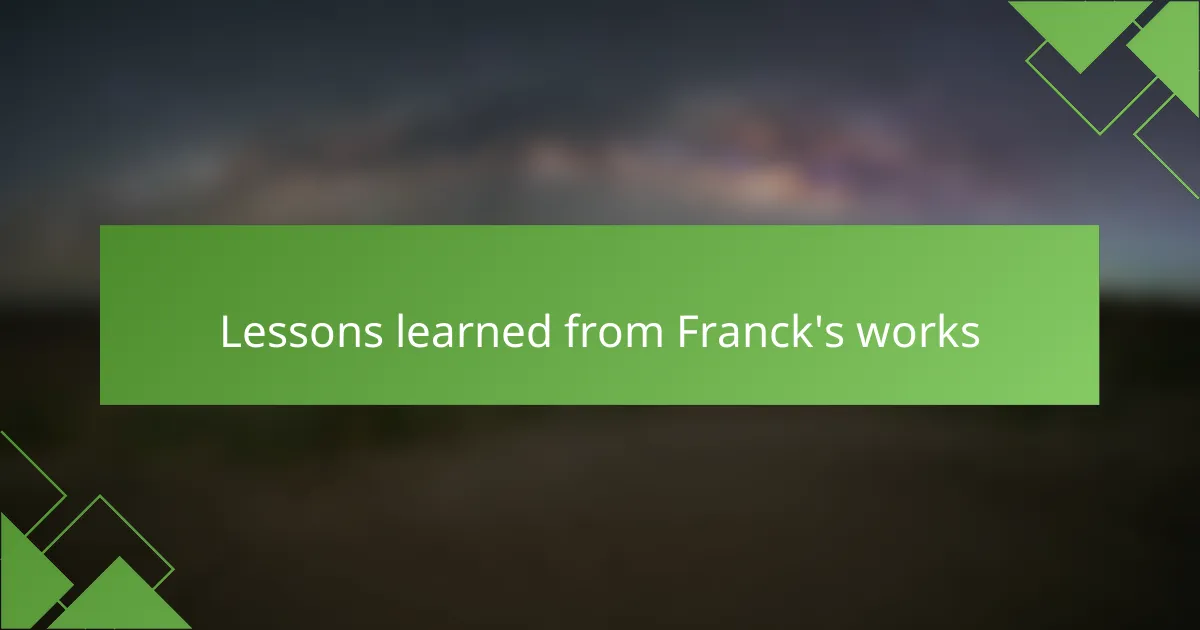
Lessons learned from Franck’s works
Martine Franck’s works offer invaluable lessons in empathy and authenticity. I remember the first time I truly connected with one of her portraits; it struck me how deeply it conveyed the subject’s emotions. This experience led me to appreciate the importance of viewing photography as a dialogue, rather than just a static image. How often do we pause to really “see” the stories behind faces?
Another lesson I’ve learned is the power of context in storytelling. Franck’s compositions place her subjects within their environments, creating a narrative that transcends the individual. I often think about how our surroundings shape our identities. Have you ever noticed how a simple backdrop can evoke a particular feeling or memory? It’s remarkable how much depth a setting can add to a photograph.
Lastly, Franck’s relentless focus on social issues has influenced my own perspective on responsibility as a photographer. I recall looking through her series on humanitarian efforts and feeling compelled to reflect on my role in the narrative. When we capture images that tell stories of struggle, we not only document the moment but also honor the lived experiences. Isn’t it inspiring to think that photography can be a catalyst for change?
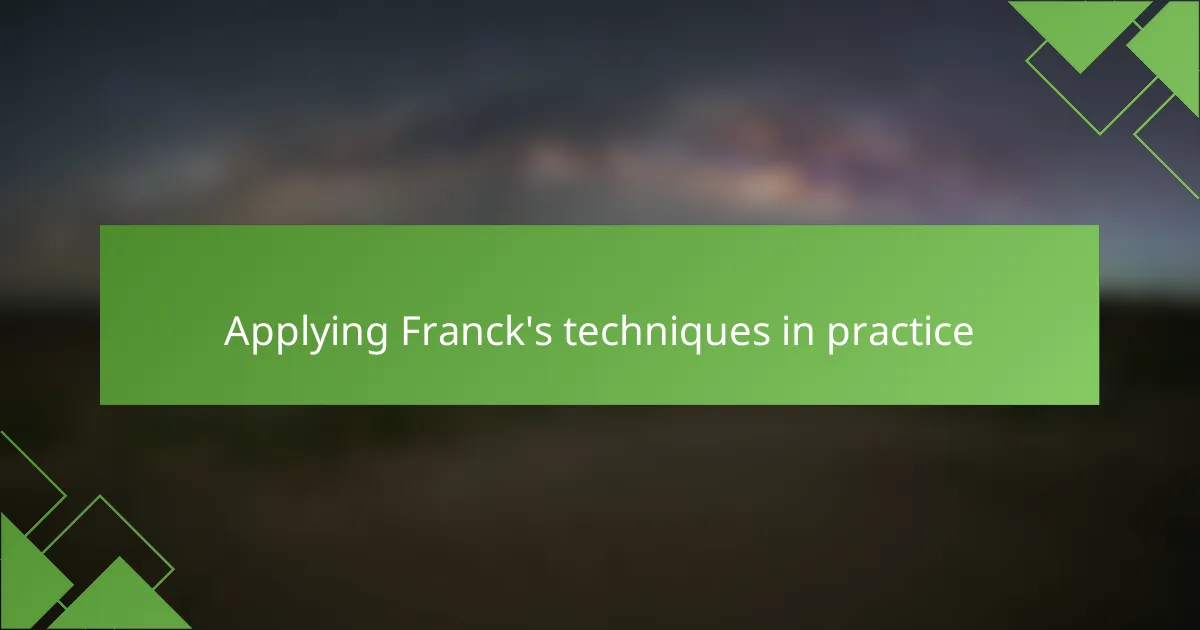
Applying Franck’s techniques in practice
Applying Martine Franck’s techniques in photography has truly transformed the way I approach my craft. One of the first things I adopted was her deliberate framing. I remember the thrill of repositioning my subjects within their environments just like she did. It felt almost magical as the images began to tell richer stories, prompting me to consider how every backdrop contributes to the narrative I want to convey.
Her use of natural light has also become a hallmark of my photography. I often find myself waiting for that perfect moment when the soft light pours in, reminiscent of how Franck captured warmth in her portraits. There was a time when I shot a local event at sunset; the golden hour illuminated everything in such a way that the photographs practically radiated emotion. I realized then how light can enhance the essence of a moment, just like Franck demonstrated throughout her work.
Lastly, the emphasis she’s placed on social commentary resonates deeply with me. I still recall the profound impact of encountering her series on social justice issues. It drove me to seek out stories in my community that deserve to be told. When I look through my own photographs now, I ask myself: am I merely capturing an image, or am I shedding light on a deeper narrative? This ongoing self-reflection keeps the soul of my work aligned with Franck’s commitment to visibility and understanding.